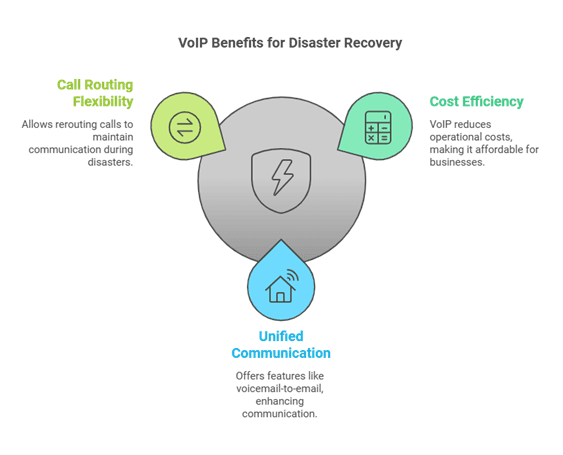Effective communication is crucial for maintaining operations and ensuring customer satisfaction in today’s business environment. Voice over Internet Protocol (VoIP) technology delivers a flexible and cost-effective solution compared to traditional phone systems. With the increasing reliance on VoIP for daily operations, the need for a robust disaster recovery plan has never been more critical. A disaster recovery plan outlines an organization’s steps to restore its communication capabilities during a crisis, such as natural disasters, cyberattacks, or technical failures. Without a comprehensive VoIP disaster recovery plan, businesses risk prolonged communication outages that can lead to financial losses and damage their reputation.
 Let us guide you through the essential steps to implement an effective VoIP disaster recovery plan. From understanding the risks and assessing your organization’s needs to developing, implementing, and maintaining your plan, we’ll cover everything you need to ensure your communication systems remain operational during emergencies. By prioritizing disaster recovery in your VoIP strategy, you can safeguard your organization’s communication ability, no matter the circumstances.
Let us guide you through the essential steps to implement an effective VoIP disaster recovery plan. From understanding the risks and assessing your organization’s needs to developing, implementing, and maintaining your plan, we’ll cover everything you need to ensure your communication systems remain operational during emergencies. By prioritizing disaster recovery in your VoIP strategy, you can safeguard your organization’s communication ability, no matter the circumstances.
Benefits of VoIP in Disaster Recovery
Implementing VoIP technology can enhance an organization’s disaster recovery capabilities. Here are some key benefits:
- Cost Efficiency and Scalability: VoIP solutions often have lower operational costs than traditional phone systems. They allow businesses to scale their communication needs easily without incurring significant expenses.
- Unified Communication Features:: VoIP platforms typically offer a range of features such as voicemail-to-email, call forwarding, and conferencing tools that can be invaluable during emergencies.
- Flexibility in Routing Calls: : In a disaster scenario, rerouting calls to different locations or devices (such as mobile phones) ensures that communication remains uninterrupted.
Assessing Risks and Needs
Conducting a Risk Assessment
Before developing a disaster recovery plan, it is essential to conduct a thorough risk assessment. This process involves finding potential threats that could disrupt communication systems. Common risks include:
- Natural Disasters: Hurricanes, earthquakes, floods, or fires can physically damage infrastructure.
- Cyberattacks: Increasingly sophisticated cyber threats can compromise communication systems or render them inoperable.
- Technical Failures: Hardware malfunctions or software issues can lead to unexpected downtime.
Once potential threats are identified, evaluate the impact of communication failures on business operations. Consider how long your organization could function without effective communication and what consequences might arise from extended outages.
Determining Communication Needs
Assess your organization’s communication needs. This involves analyzing your current communication infrastructure and identifying key personnel who play critical roles during emergencies. Consider the following questions:
- What are the most critical functions that rely on VoIP?
- Who are the primary stakeholders that need to be contacted during a crisis?
- What alternative methods of communication (e.g., mobile phones, text messaging) should be included in your plan?
By understanding these needs, you can tailor your disaster recovery plan effectively.
Developing the VoIP Disaster Recovery Plan
A comprehensive VoIP disaster recovery plan should include several key components:
- Call Routing and Redirection Strategies: Establish protocols for rerouting calls to alternative numbers or devices when primary systems fail. This may involve using cloud-based services that allow for easy reconfiguration.
- Backup Internet Solutions: Ensure backup internet options are available (e.g., secondary ISPs or mobile hotspots) so that communication can continue even if primary internet services are disrupted.
- Integration with Existing IT Disaster Recovery Strategies: Your VoIP disaster recovery plan should complement broader IT disaster recovery efforts. Ensure that all teams are aligned in their strategies.
Implementing the Plan
Installation and Configuration Once you have developed your disaster recovery plan, it’s time to implement it; start by installing and configuring your VoIP systems with built-in redundancy features. This may include:
- Setting up multiple servers in different geographic locations.
- Configuring call forwarding options so that calls can be redirected seamlessly during emergencies.
Ensure that mobile devices are integrated into your system so employees can stay connected from anywhere.
Testing and Maintenance
Regular Testing of the Disaster Recovery Plan
A well-designed disaster recovery plan is only effective if it is regularly tested. Schedule drills to simulate various emergency scenarios and ensure all components function as intended. During these tests:
- Evaluate response times and effectiveness.
- Identify any weaknesses or areas for improvement in your plan.
Regular testing will help ensure all team members are familiar with procedures and can execute them under pressure.
Monitoring and Continuous Improvement
Implement monitoring solutions for real-time health checks of your VoIP system. Third-party monitoring services can alert you to potential issues before they escalate into significant problems. Continuously improve your disaster recovery plan based on testing outcomes and evolving business needs. Regularly update contact information and call routing settings to reflect any organizational changes.
Conclusion
In conclusion, implementing a robust VoIP disaster recovery plan is essential for ensuring uninterrupted communication during crises. By understanding the role of VoIP technology in disaster recovery, assessing risks and needs, developing a comprehensive plan, implementing it effectively, and maintaining it through regular testing and monitoring, organizations can safeguard their ability to communicate effectively no matter what challenges arise. As businesses increasingly rely on digital communication solutions like VoIP, prioritizing disaster recovery becomes not just a best practice but a necessity for long-term success. By taking proactive steps now, organizations can mitigate risks associated with potential disruptions and maintain operational continuity even in the face of adversity.
We at Intratel offer superior VoIP services at the best prices. Call us now!
